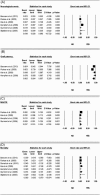Clinical outcomes of automated anastomotic devices: A metanalysis
- PMID: 31472023
- PMCID: PMC6900158
- DOI: 10.1111/jocs.14186
Clinical outcomes of automated anastomotic devices: A metanalysis
Abstract
Background and aims: We investigated neurological events, graft patency, major adverse cardiovascular events (MACEs), and mortality at 1 year following coronary artery bypass grafting (CABG) surgery using automated proximal anastomotic devices (APADs) and compared the overall rates with the current literature.
Methods: A systematic review of all available reports of APADs use in the literature was conducted. Cumulative incidence and 95% confidence interval (CI) were the main statistical indexes. Nine observational studies encompassing a total of 718 patients were included at the end of the selection process.
Results: The cumulative event rate of neurological complications was 4.8% (lower-upper limits: 2.8-8.0, P < .001; I2 = 72.907%, P = .002; Egger's test: intercept = -2.47, P = 0.16; Begg and Mazumdar test: τ = -0.20, p = 0.57). Graft patency was 90.5% (80.4 to 95.7, P < .001; I2 = 76.823%, P = .005; Egger's test: intercept = -3.04, P = .10; Begg and Mazumdar test: τ = -0.67, P = .17). Furthermore, the overall incidence of MACEs was 3.7% (1.3-10.4, P < .001; I2 = 51.556%, P = .103; Egger's test: intercept = -1.98, P = < .11; Begg and Mazumdar test: τ = -0.67, P = .17). Finally, mortality within 1 year was 5% (3.5-7, P < .001; I2 = 29.675%, P = .202; Egger's test: intercept = -0.91, P = .62; Begg and Mazumdar test: τ = -0.04, P = .88).
Conclusions: APADs do not seem to be correlated with a reduction of either neurological events or mortality. By contrast, these tools showed satisfactory one-year graft patency and a low incidence of MACEs. Further research on this topic is warranted.
Keywords: coronary artery bypass grafting; coronary artery disease; proximal anastomoses.
© 2019 The Authors. Journal of Cardiac Surgery published by Wiley Periodicals, Inc.
Conflict of interest statement
The authors declare no conflicts of interest.
Figures
Similar articles
-
Automatic connector devices for proximal anastomoses do not decrease embolic debris compared with conventional anastomoses in CABG.Eur J Cardiothorac Surg. 2004 Jun;25(6):993-1000. doi: 10.1016/j.ejcts.2004.02.036. Eur J Cardiothorac Surg. 2004. PMID: 15145000 Clinical Trial.
-
Comparison of Mid-Term Graft Patency between On-Pump and Off-Pump Coronary Artery Bypass Grafting.Ann Thorac Cardiovasc Surg. 2017 Jun 20;23(3):141-148. doi: 10.5761/atcs.oa.16-00302. Epub 2017 Apr 19. Ann Thorac Cardiovasc Surg. 2017. PMID: 28428447 Free PMC article.
-
Adjunct coronary endarterectomy increases myocardial infarction and early mortality after coronary artery bypass grafting: a meta-analysis.Interact Cardiovasc Thorac Surg. 2014 Sep;19(3):462-73. doi: 10.1093/icvts/ivu157. Epub 2014 Jun 3. Interact Cardiovasc Thorac Surg. 2014. PMID: 24893867 Review.
-
Results of the Minimally Invasive Coronary Artery Bypass Grafting Angiographic Patency Study.J Thorac Cardiovasc Surg. 2014 Jan;147(1):203-8. doi: 10.1016/j.jtcvs.2013.09.016. Epub 2013 Oct 30. J Thorac Cardiovasc Surg. 2014. PMID: 24183338 Clinical Trial.
-
Stroke Rates Following Surgical Versus Percutaneous Coronary Revascularization.J Am Coll Cardiol. 2018 Jul 24;72(4):386-398. doi: 10.1016/j.jacc.2018.04.071. J Am Coll Cardiol. 2018. PMID: 30025574
References
-
- Calafiore AM, Di Mauro M, Teodori G, et al. Impact of aortic manipulation on incidence of cerebrovascular accidents after surgical myocardial revascularization. Ann Thorac Surg. 2002;73(5):1387‐1393. - PubMed
-
- Kapetanakis EI, Stamou SC, Dullum MKC, et al. The impact of aortic manipulation on neurologic outcomes after coronary artery bypass surgery: a risk‐adjusted study. Ann Thorac Surg. 2004;78(5):1564‐1571. - PubMed
Publication types
MeSH terms
LinkOut - more resources
Full Text Sources
Medical



